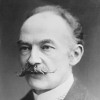“ A field-man is a personality afield; a field-woman is a portion of the field ”
Thomas Hardy, Tess of the d'Urbervilles (1891). copy citation
| Author | Thomas Hardy |
|---|---|
| Source | Tess of the d'Urbervilles |
| Topic | personality women |
| Date | 1891 |
| Language | English |
| Reference | |
| Note | |
| Weblink | http://www.gutenberg.org/files/110/110-h/110-h.htm |
Context
“But those of the other sex were the most interesting of this company of binders, by reason of the charm which is acquired by woman when she becomes part and parcel of outdoor nature, and is not merely an object set down therein as at ordinary times. A field-man is a personality afield; a field-woman is a portion of the field; she had somehow lost her own margin, imbibed the essence of her surrounding, and assimilated herself with it.
The women—or rather girls, for they were mostly young—wore drawn cotton bonnets with great flapping curtains to keep off the sun, and gloves to prevent their hands being wounded by the stubble.”
source


